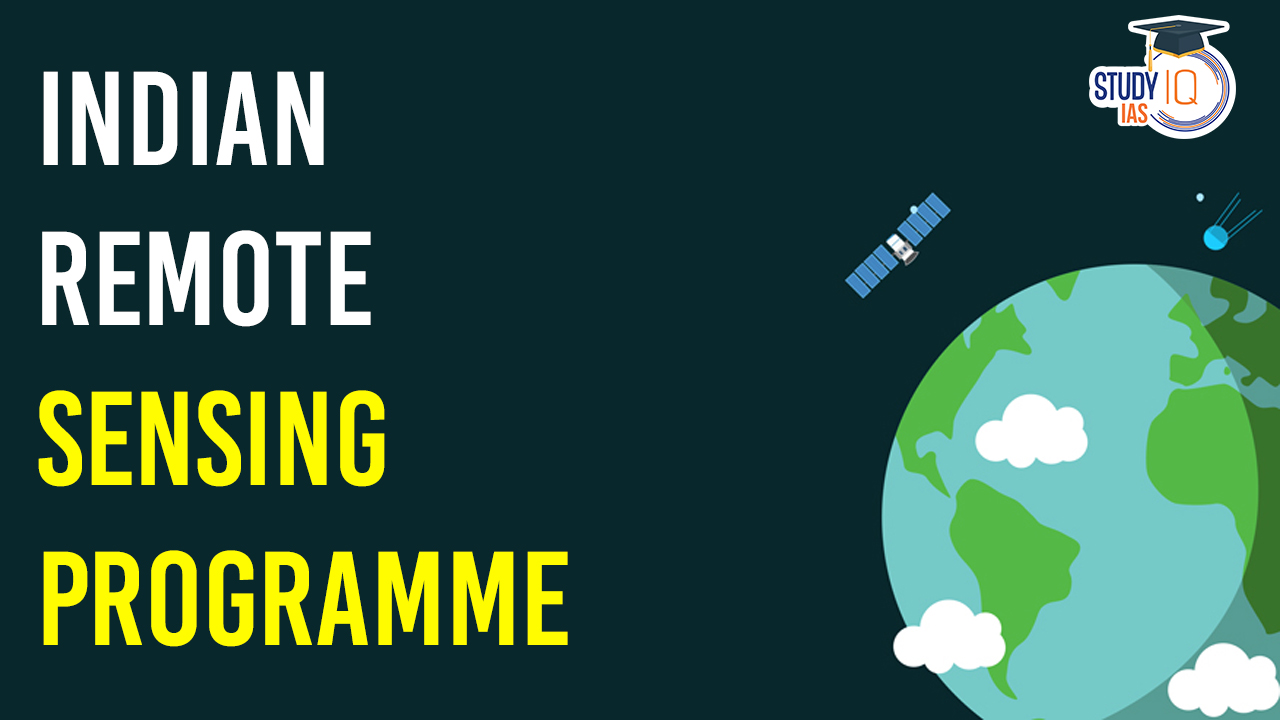Table of Contents
The Indian Remote Sensing (IRS) program is a series of Earth observation satellites launched by the Indian Space Research Organisation (ISRO) to gather various types of remote sensing data for a wide range of applications. The program has played a significant role in monitoring and managing India’s natural resources, environmental changes, urban planning, disaster management, and agricultural development.
Indian Remote Sensing Program
The Indian Remote Sensing (IRS) satellite system was launched in 1988 by the Indian Space Research Organization (ISRO). The first satellite, IRS-1A, was launched on March 17, 1988. The IRS program currently has more than a dozen satellites in operation. The IRS is the largest civilian remote-sensing satellite constellation in the world.
The IRS program also includes the Indo-French Joint Satellite Mission, Megha-Tropiques, which studies the water cycle and energy exchanges in the tropics.
Udupi Ramachandra Rao is considered the father of the remote satellite program in India. Rao was instrumental in the development of the ASLV, the PSLV, and GSLV rocket.
Indian Institute of Remote Sensing (IIRS)
The Indian Institute of Remote Sensing (IIRS) is located in Dehradun, Uttarakhand, India. The IIRS is a government institute that was established in 1966. It is a training and education arm of the Indian Department of Science. The IIRS’s objective is to build capacity in Remote Sensing and Geo-informatics through education and training programs at the postgraduate level.
Indian Remote Sensing (IRS) Satellite System
The Indian Remote Sensing (IRS) Satellite System is a crucial component of India’s space program, featuring a constellation of satellites equipped with sensors to capture Earth data from space. These sensors detect various forms of radiation, enabling applications like weather monitoring, disaster management, agriculture, and forestry.
The launch of India’s first civilian remote sensing satellite, IRS-1A, in 1988 marked a significant milestone in Earth observation. The National Natural Resources Management System (NNRMS) oversees Indian Earth Observation using payloads on thematic series of Indian Remote Sensing Satellites (IRS) and the Indian National Satellite System (INSAT). The system is known for one of the world’s largest constellations, offering data with diverse resolutions. The National Remote Sensing Centre (NRSC) serves as a central distribution hub for data, supporting various applications for society and the environment.
Types of Indian Remote Sensing (IRS)
The Indian Remote Sensing (IRS) program has launched various types of satellites, each equipped with specific sensors and capabilities to cater to different Earth observation needs. As of my last knowledge update in January 2022, here are some of the notable types of IRS satellites:
- IRS-1 Series: The IRS-1 series was among the earliest remote sensing satellites in the program. It included satellites like IRS-1A, IRS-1B, IRS-1C, and IRS-1D, which were equipped with different sensors for applications such as agriculture, forestry, and natural resource management.
- IRS-2 Series: The IRS-2 series, including IRS-2A and IRS-2B, continued to expand the capabilities of the program with improved sensors and enhanced data quality for applications like land use mapping and environmental monitoring.
- IRS-P Series: The IRS-P series focused on specific thematic applications, with satellites like IRS-P2, IRS-P3, and IRS-P4 dedicated to areas such as oceanography, forestry, and agriculture.
- Cartosat Series: The Cartosat series of satellites, including Cartosat-1, Cartosat-2, and Cartosat-2B, are known for their high-resolution panchromatic and multispectral imaging capabilities. They are primarily used for cartography, urban planning, infrastructure development, and defense applications.
- Resourcesat Series: The Resourcesat series, including Resourcesat-1 and Resourcesat-2, are designed for resource monitoring and management. These satellites carry sensors for multispectral and hyperspectral imaging.
- Oceansat Series: The Oceansat series, which includes Oceansat-1 and Oceansat-2, is dedicated to ocean and atmospheric applications. They carry sensors for ocean color monitoring and weather forecasting.
- RISAT Series: Radar Imaging Satellite (RISAT) series, with satellites like RISAT-1 and RISAT-2, are equipped with synthetic aperture radar (SAR) for all-weather, day-and-night Earth observation. These satellites are essential for applications like agriculture, forestry, and disaster management.
- HySIS: Hyperspectral Imaging Satellite (HySIS) is designed for hyperspectral imaging, enabling detailed spectral analysis of Earth’s surface for various applications, including agriculture and environmental monitoring.
List of Indian Remote Sensing (IRS) Satellites
| Satellite | Launch Date | Launch Vehicle | Application |
| EOS-04 | Feb 14, 2022 | PSLV-C52/EOS-04 Mission | Earth Observation |
| EOS-01 | Nov 07, 2020 | PSLV-C49/EOS-01 | Disaster Management System, Earth Observation |
| RISAT-2BR1 | Dec 11, 2019 | PSLV-C48/RISAT-2BR1 | Disaster Management System, Earth Observation |
| Cartosat-3 | Nov 27, 2019 | PSLV-C47 /Cartosat-3 Mission | Earth Observation |
| RISAT-2B | May 22, 2019 | PSLV-C46 Mission | Disaster Management System, Earth Observation |
| HysIS | Nov 29, 2018 | PSLV-C43 /HysIS Mission | Earth Observation |
| Cartosat-2 Series | Jan 12, 2018 | PSLV-C40/Cartosat-2 Series Satellite Mission | Earth Observation |
| Cartosat-2 Series | Jun 23, 2017 | PSLV-C38 /Cartosat-2Series Satellite | Earth Observation |
| Cartosat -2 Series | Feb 15, 2017 | PSLV-C37 /Cartosat -2 Series Satellite | Earth Observation |
| RESOURCESAT-2A | Dec 07, 2016 | PSLV-C36 /RESOURCESAT-2A | Earth Observation |
| SCATSAT-1 | Sep 26, 2016 | PSLV-C35 /SCATSAT-1 | Climate & Environment |
| INSAT-3DR | Sep 08, 2016 | GSLV-F05 /INSAT-3DR | Climate & Environment, Disaster Management System |
| CARTOSAT-2 Series | Jun 22, 2016 | PSLV-C34 /CARTOSAT-2Series Satellite | Earth Observation |
| INSAT-3D | Jul 26, 2013 | Ariane-5 VA-214 | Climate & Environment, Disaster Management System |
| SARAL | Feb 25, 2013 | PSLV-C20/SARAL | Climate & Environment, Earth Observation |
| RISAT-1 | Apr 26, 2012 | PSLV-C19/RISAT-1 | Earth Observation |
| Megha-Tropiques | Oct 12, 2011 | PSLV-C18/Megha-Tropiques | Climate & Environment, Earth Observation |
| RESOURCESAT-2 | Apr 20, 2011 | PSLV-C16/RESOURCESAT-2 | Earth Observation |
| CARTOSAT-2B | Jul 12, 2010 | PSLV-C15/CARTOSAT-2B | Earth Observation |
| Oceansat-2 | Sep 23, 2009 | PSLV-C14 /OCEANSAT-2 | Climate & Environment, Earth Observation |
| RISAT-2 | Apr 20, 2009 | PSLV-C12 /RISAT-2 | Earth Observation |
| CARTOSAT – 2A | Apr 28, 2008 | PSLV-C9 /CARTOSAT – 2A | Earth Observation |
| IMS-1 | Apr 28, 2008 | PSLV-C9 /CARTOSAT – 2A | Earth Observation |
| CARTOSAT-2 | Jan 10, 2007 | PSLV-C7 /CARTOSAT-2 /SRE-1 | Earth Observation |
| CARTOSAT-1 | May 05, 2005 | PSLV-C6/CARTOSAT-1/HAMSAT | Earth Observation |
| IRS-P6 /RESOURCESAT-1 | Oct 17, 2003 | PSLV-C5 /RESOURCESAT-1 | Earth Observation |
| Technology Experiment Satellite (TES) | Oct 22, 2001 | PSLV-C3 / TES | Earth Observation |
| Oceansat (IRS-P4) | May 26, 1999 | PSLV-C2/IRS-P4 | Earth Observation |
| IRS-1D | Sep 29, 1997 | PSLV-C1/IRS-ID | Earth Observation |
| IRS-P3 | Mar 21, 1996 | PSLV-D3 / IRS-P3 | Earth Observation |
| IRS-1C | Dec 28, 1995 | Molniya | Earth Observation |
| IRS-P2 | Oct 15, 1994 | PSLV-D2 | Earth Observation |
| IRS-1B | Aug 29, 1991 | Vostok | Earth Observation |
| IRS-1A | Mar 17, 1988 | Vostok | Earth Observation |
| Rohini Satellite RS-D2 | Apr 17, 1983 | SLV-3 | Earth Observation |
| Bhaskara-II | Nov 20, 1981 | C-1 Intercosmos | Earth Observation, Experimental |
| Rohini Satellite RS-D1 | May 31, 1981 | SLV-3D1 | Earth Observation |
Applications of Indian Remote Sensing (IRS)
The Indian Remote Sensing (IRS) satellites have been instrumental in providing valuable data for a wide range of applications. These applications cut across various sectors and contribute to the socioeconomic development and environmental management of India. Some of the key applications of IRS satellites include:
- Agriculture: IRS satellites play a crucial role in agricultural management. They provide data for crop monitoring, yield estimation, pest and disease outbreak prediction, and efficient water resource management.
- Forestry: IRS data is used for forest mapping, monitoring deforestation, and managing forest resources. It aids in forest cover assessment, tree species identification, and fire detection.
- Water Resources Management: IRS satellites assist in the monitoring and management of water resources, including river basin planning, reservoir management, and flood forecasting. They also aid in the assessment of water quality and availability.
- Urban Planning: Urban planners utilize IRS data for city planning, infrastructure development, and land-use mapping. This is essential for sustainable urban growth and efficient resource allocation.
- Disaster Management: IRS satellites are invaluable for disaster management. They provide real-time data for disaster preparedness, response, and recovery, covering natural disasters like floods, cyclones, earthquakes, and landslides.
- Environmental Monitoring: These satellites are used for environmental studies, including monitoring land degradation, wetland conservation, and biodiversity assessment. They contribute to environmental impact assessments for various projects.
- Rural Development: IRS data is utilized for rural development initiatives, such as watershed management, soil health assessment, and rural infrastructure planning.
- Cartography and Mapping: The high-resolution imagery from satellites like Cartosat is essential for cartography, map generation, and topographic surveys.
- Infrastructure Development: IRS data aids in infrastructure development, including transportation planning, energy infrastructure, and industrial site selection.
- Weather Forecasting: IRS satellites, especially those with atmospheric sensors, provide inputs for weather forecasting and climate studies. They contribute to climate modeling and monitoring climate change.
- Security and Defense: Some IRS satellites have applications in defense, supporting activities such as border surveillance, target identification, and situational awareness.
- Healthcare: Remote sensing data can be used for monitoring the spread of vector-borne diseases, such as malaria, and planning healthcare interventions.
- Telecommunications: INSAT satellites, which are part of the IRS program, support telecommunications and broadcasting services.
- Education and Research: IRS data is valuable for educational institutions and research organizations for a wide range of scientific studies and research projects.
Advantages of Remote Sensing Satellites (IRS)
Satellite-based remote sensing offers several advantages over other methods due to its extensive coverage, efficiency in time and cost, and versatility:
- Comprehensive Coverage: Remote sensing satellites can capture data over vast areas, facilitating regional surveys across a wide spectrum of topics and enabling the identification of significant features.
- Repetitive Coverage: These satellites provide repeated coverage, enabling the monitoring of dynamic phenomena like changes in water bodies, agricultural activities, and more over time.
- Multi-Altitude Data Collection: Satellite sensors can collect data from various altitudes, allowing for the observation of Earth’s surface and atmosphere from different perspectives.
- Access to Inaccessible Areas: Remote sensing satellites are invaluable for data collection in remote or difficult-to-reach regions where ground-based data collection may be challenging or impossible. They provide insights into otherwise inaccessible areas.
Indian Remote Sensing (IRS) program UPSC
The Indian Remote Sensing (IRS) program, initiated by the Indian Space Research Organisation (ISRO) in 1988, boasts a constellation of Earth observation satellites offering extensive coverage for a myriad of applications. These satellites aid in agriculture, forestry, water resource management, urban planning, disaster response, and more. They have played a pivotal role in India’s development. The Indian Institute of Remote Sensing (IIRS) supports education and training in remote sensing. The advantages of satellite-based remote sensing include broad coverage, repetitive monitoring, multi-altitude data collection, and accessibility to remote areas, making it a cost-effective and versatile tool for various fields.


 AI and its Regulation in India, Limitati...
AI and its Regulation in India, Limitati...
 Tuberculosis (TB), Symptoms, Causes and ...
Tuberculosis (TB), Symptoms, Causes and ...
 Silicon Photonics Enables Low-power AI A...
Silicon Photonics Enables Low-power AI A...





















